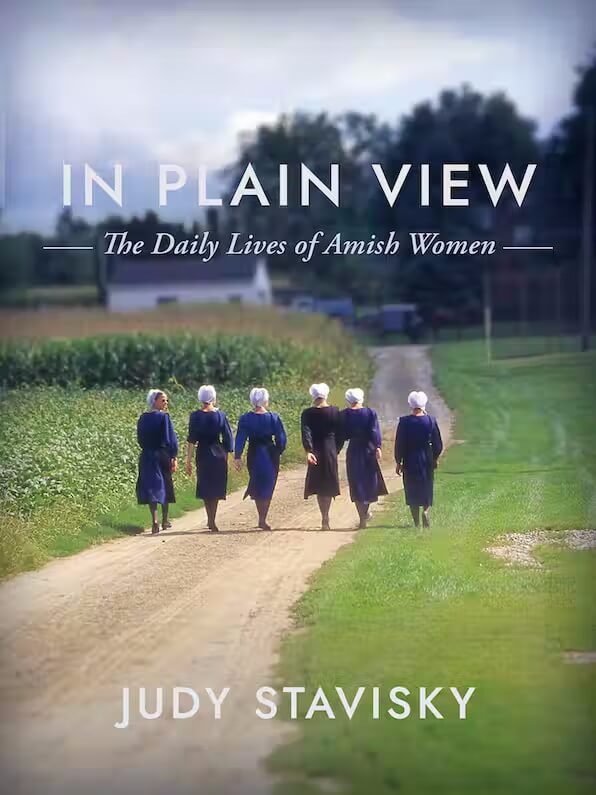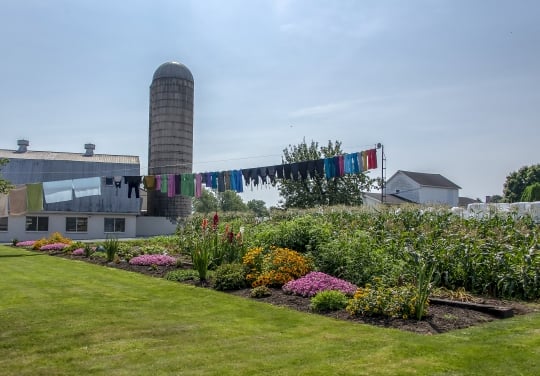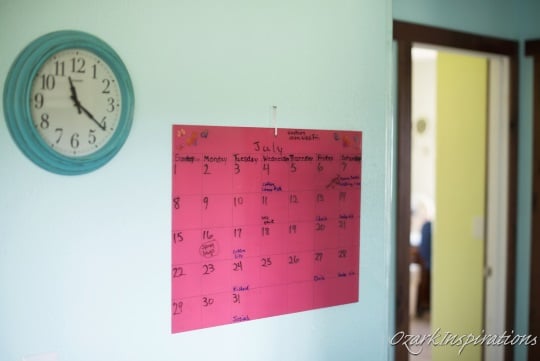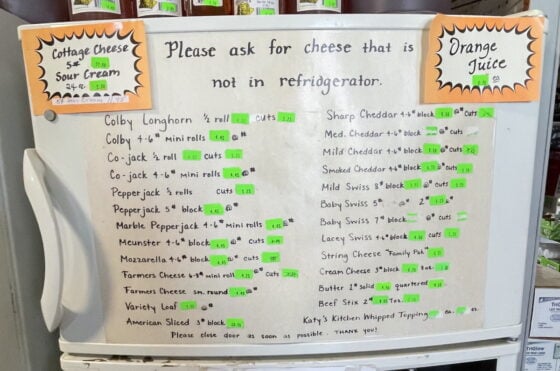In Plain View: The Daily Lives of Amish Women Book Winner & Excerpt
We’ve got a winner of In Plain View: The Daily Lives of Amish Women by Judy Stavisky today. If you didn’t catch last week’s Q&A with Judy, you can find that here. She has done a nice job of answering a number of your questions in the comments there.
But first here’s an excerpt of the book, courtesy of Herald Press. This is from pages 105-107, on gardening and spring tasks.

Excerpt from In Plain View: The Daily Lives of Amish Women
The arc of Amish life revolves around the seasons, unchanged for generations. Seed shopping at the Amish hardware store can begin as early as February. Eager gardeners reluctantly pass over seed packets that linger from last year.
When the sun finally melts the remnants of crusty snow, Amish women take note of others who may have started cultivating seeds indoors, fretting now that their own gardens have fallen behind schedule. Grooming the family garden preserves a way of life and a timeless ritual of economic necessity. Despite the blustery February weather, dreams of preparing garden plots flicker.
“By March, I am down to my last potatoes. They are a little wrinkled and soft, but they taste just fine. The really mushy ones can be saved and replanted in the early spring. I use my garden for as much as I can, for as long as I can. We can still dig up potatoes in November if there hasn’t been a frost,” an Amish mother of five confirmed.
Within a life of discipline and restraint, Amish women maintain an animated relationship with their gardens, which they carefully cultivate and dote over. The garden not only provides months of family sustenance, but it also punctuates Amish life with brilliant color. As vivid and intricate as their iconic quilts, Amish gardens burst with bold perennials and rows of wholesome vegetables. Golden evening primrose, magenta irises, and scarlet cockscomb frame a parade of ingredients for hundreds of future meals. Vines of pole beans, tomatoes, and summer squashes grow near bowling ball-sized heads of lettuce and cabbage, broccoli, and cauliflower.

Spring planting, summer harvesting, and fall canning supplant other obligations. Amish schools close early in May, releasing the children for their heavy commitments at home. The more urgent tasks of planting, picking, and canning depend on the scholars (and their teachers) pitching in as soon as possible.
Tasks of Spring
In early spring, the youngest family members pile rocks and yard debris in their wooden wagons. Small hands are perfect for weeding garden beds. As children rake out winter leaves and turn the soil, they labor in bare feet. Their soles toughen up over the summer.
“At the beginning of the summer, it hurts to walk on the big gravel stones, but by the end I don’t even notice it,” one teen shared.
Equipped with long-handled hoes, rusted shovels, and garden trowels, children follow their mother’s instructions on the correct spacing of seedlings: place the sprouts gently into the soil, tamp down, and then cover with rich dirt from the family’s compost pile.
Alongside the stout primroses and sweet peonies, the first stalks of rhubarb, asparagus, and early spinach poke above ground. Some women raise eye-catching blossoms for the visual joy they bring. Other women earn extra income by selling excess nosegays from their roadside self-serve stands. Arranged in recycled mayonnaise jars and empty half-gallon milk cartons, flower bouquets sell for $5 if the customer leaves the container behind ($7 with the container). Early spring also features the surplus from prolific berry patches, green onions bunched in rubber bands, or rumpled paper bags filled with spring potatoes for a dollar or two.

“Honk if you need more change,” reads the hand-painted sign at the unattended stand just outside of Narvon, Pennsylvania.
Most roadside self-service stands rely on buyers slipping coins and dollar bills into the honor box, a small metal or wooden container with a carved out slit for payment. Some honor boxes do not lock. The ethos of the cash box assumes that customers will leave exact change or make the correct change from the bills and coins in the box.
From time to time, I spot an Amish child peeking from behind a traditional green window shade common in Lancaster Amish homes, watching the customers peruse the items for sale. This simple exchange of commerce transmits a core Amish value to their children—be honest, even when no one is looking.
From In Plain View: The Daily Lives of Amish Women by Judy Stavisky. Used by permission of Herald Press. All rights reserved.
Book winner
I just used random.org to select a random winner from among your comment entries. The winner is:
Comment #45, Rita Leonard
Congrats Rita, please send me an address so you can get your book (ewesner[at]gmail[dot]com).
How to get the book
Thank you to Judy and to Herald Press. In Plain View is available via outlets including Herald Press/MennoMedia, bookshop.org, Barnes & Noble, and Amazon. Check it out, I think you’ll enjoy and learn from it.







What fine, evocative writing!
Judy Stavisky is an excellent writer. What a find.
Just ordered a copy from Amazon.
What fine evocative writing
Boyce, thank you for your comment. It made my day! And much appreciation for purchasing the book. I would welcome your thought on the book after you have a chance to read it. Best, J
Great description of spring gardening!
I can picture in my mind the Amish women working hard in their gardens. I would love that kind of life!
Great description of spring gardening
Jeanne, it is a very arduous life. There is little time for puttering in the garden, more of a focus on the food to be harvested and when.
Congratulations Rita!
And thank you to Judy Stavisky for writing this book. I’m looking forward to reading it. Reading the excerpts from the book brings back so many wonderful memories of my childhood.
When is "art" acceptable? Do you know of any Amish women who work in pottery?
I purchased “In Plain View,” by Judy Stavisky. It’s excellent.
I have an unusual question pertaining to Old Order Amish being craftsmen or artists. Clearly, a buggy maker, blacksmith, carpenter, seamstress, cook, etc., often become expert at his/her work.
Do you know of any women who create pottery, especially dishware? I believe that many Amish homes are plain when it comes to “art,” but some pottery is utilitarian, not fancy. Would plain pottery be acceptable?
Also, if any Amish women did create pottery, it’s possible they could sell their product to English, not Amish.
I guess, in a broader sense, this inquiry is about how the Amish differentiate between items that are too worldly and the difference between art being acceptable or not. I’ve heard that in Amish schools there are art classes. I wonder what they are like. Please consider a blog about Amish art classes in school!
Thanks for listening.
Sincerely, Jim
When is art acceptable?
Jim, my apologies for the much belated response. You ask a very important question and one I cannot answer but will do some digging with Amish friends. I have seen drawings executed by the Amish but have never heard about pottery or an Amish potter. My first instinct is that the Amish are very intentional with their time and making plates from clay might require more time that one can justify, given the low cost of inexpensive dish ware. While the children draw and color (and their artwork is posted on the walls of the school), I have not heard of art classes in the schools I visited.
Certainly topics worthy of further discussion!